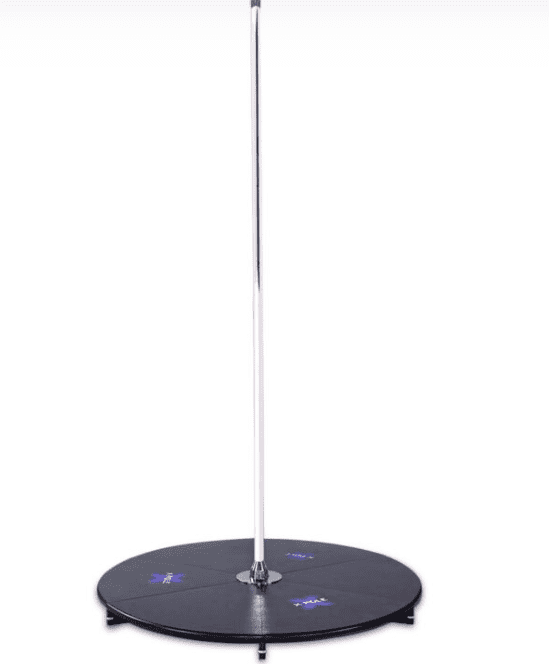Thinking of learning a few pole dance tricks but not sure where to start?
Or maybe you’ve nailed the spins and climbs — now you’re stuck in a loop, doing the same combos over and over again?
Whether you’re a total beginner or levelling up to advanced pole tricks, here’s the real talk breakdown of what works, what hurts, and what actually gets you stronger on the pole.
Let’s jump straight in.
Beginner Pole Dance Tricks That Don’t Suck
Forget overcomplicated routines. Start with tricks that teach control.
These lay your foundation:
- Fireman Spin
The classic. Grip, lift, spin. Feels good. Builds confidence fast. - Chair Spin
Looks smooth, feels floaty. Great for flow practice. - Pole Sit
Burns. But gets you used to grip with your thighs. Master this and your pole pain tolerance skyrockets. - Back Hook Spin
A step up in coordination, with a nice rotation that’s easy to link into combos. - Climbs
Basic climbs suck at first. But trust me, the grip strength you build here pays off later.
✅ Tips for beginners:
- Always engage your core
- Use dry hands (hello, grip aids)
- Train both sides — don’t be a one-trick pony
Intermediate Pole Tricks That Turn Heads
Now you’re building muscle and flow. Let’s level it up.
Here’s where strength meets style:
- Jasmine
Beautiful side-lean pose that teaches body tension and balance. - Butterfly
The first trick where you feel like you’re really doing pole. Use the wall if you’re scared at first. - Superman
Oof. This one’s painful. But once you land it, you’ll post it everywhere. - Side Climb
Fancy variation of basic climbs — great for linking tricks together. - Spinning Pole Combos
Transition your tricks on a spinning pole and the game changes. Core on fire, momentum hard to control — but oh, so worth it.
Advanced Pole Tricks (For When You’re a Freakin’ Beast)
We’re talking jaw-droppers, not just fitness.
If you’ve got the strength and skin grip, add these:
- Iron X
Iconic. Brutal. Full-on showoff move. Need massive core and shoulder strength. - Ayesha
A strength-balance combo move. Kills your wrists at first. - Deadlift
No bounce, no kick — just raw power. If you can do this clean, you’re elite. - Hands-free shoulder mount
If you’re hitting this, I’m impressed. High-risk, high-reward.
Pole Trick Safety 101 (So You Don’t Die)
Pole dancing is hard enough. Don’t let ego kill your progress.
Here’s how not to wreck your body:
- Always warm up — don’t skip this, no matter how advanced you are
- Crash mats aren’t optional — especially for inverted tricks
- Don’t just copy Instagram — form over flex
- Spot each other. Pole friends = safety net
- Rest days = better tricks. Overtraining leads to injury
How To Link Pole Tricks (Without Looking Like a Robot)
Pole isn’t just trick after trick. You gotta connect the dots.
Start here:
- Add transitions: leg waves, hip rolls, pirouettes
- Use tempo changes: fast trick, slow descent
- Incorporate the floor. A sexy crawl can reset everything
- Practice exits just as much as entries. It’s the full picture that matters.
Struggling With Grip?
Welcome to pole.
Fix it fast:
- Try Dry Hands, iTac, or Mighty Grip
- Clean your pole with vodka or rubbing alcohol
- Keep your hands dry — sweaty palms = game over
- Don’t rely on grip aid forever. Build real grip strength off the pole too
Bonus: Pole Combos To Try (And Film)
Try these pole trick combos based on your level:
Beginner Combo:
Fireman Spin → Pole Sit → Back Hook Spin → Dismount
Intermediate Combo:
Chair Spin → Jasmine → Side Climb → Superman
Advanced Combo:
Ayesha → Deadlift → Iron X → Controlled Descent
FAQs About Pole Dance Tricks
Let’s go full-depth with these — long-form, honest, and clear-cut answers your audience actually wants.
Extended FAQs: Pole Dance Tricks
Is pole dancing good for building muscle?
Absolutely. Pole dancing isn’t just cardio in heels — it’s a full-body strength workout.
You’re lifting your own bodyweight constantly, which fires up:
- Core — your abs are always working, especially during spins, climbs, and inversions.
- Upper body — shoulders, biceps, triceps, forearms all get shredded from holding on and pulling up.
- Grip strength — most people don’t realise how weak their grip is until they try a pole sit and slide right off.
- Legs and glutes — squeezing the pole during tricks or holding splits builds serious muscle over time.
It’s bodyweight training on steroids — but way more fun.
Do you need to be flexible for pole tricks?
No — not at the beginning. Most beginner tricks rely more on strength and control than flexibility.
But if you want to move into tricks like:
- Extended butterfly
- Jade split
- Allegra
- Russian layback
Then flexibility becomes a game-changer. Start stretching now. Add active flexibility drills, not just passive stretches. That way, your strength and flexibility grow together.
If you can’t touch your toes, don’t panic — just start.
How long until I can do advanced tricks?
It varies. Most people hit advanced tricks within 12 to 18 months of regular training (2–3 times a week).
But that depends on:
- How often you train
- Whether you’re cross-training (like yoga or strength work)
- How quickly you recover
- Your pain tolerance (pole bruises are real)
- Your coach and class structure
Some people hit Ayesha or Shoulder Mounts in 6 months. Others take 2 years.
Focus on small wins — get your climbs clean, your spins strong, and your inverts safe.
Can I learn pole dance tricks at home?
Yes — but do it smart.
Here’s what you’ll need:
- A properly installed pole (don’t cheap out — invest in X-Pole or Lupit)
- Crash mat — especially if you’re trying inverts
- A mirror or a way to film yourself
- Access to online tutorials or structured programs
- Basic knowledge of warmups and cooldowns
BUT… learning alone comes with risks. Without spotting, bad habits can creep in. You might not even realise your form is off until you plateau or get injured.
So mix in studio classes or private coaching whenever you can.
Does pole dancing help with weight loss?
It can — but not on its own.
Pole burns calories (anywhere from 250 to 500+ per session), but your diet still matters.
What pole will do is build lean muscle, tighten your body, and make you stronger — and that changes your shape way faster than endless cardio ever could.
Think toned arms, tighter core, and visible definition. If fat loss is the goal, combine pole with solid nutrition and strength training.
Why do my legs bruise so much from pole?
Because your body’s not used to gripping with skin.
Most tricks involve contact with thighs, inner arms, and even shins — that creates pressure.
Bruising is common, especially early on.
To reduce it:
- Warm up properly
- Ease into tricks — don’t hang too long in pain
- Take rest days between hard sessions
- Arnica gel or cold compress post-training
Over time, your skin adapts. Your pain tolerance increases. Bruising fades faster.
You’re basically building a “pole callus” over time.
How do I improve grip strength for pole tricks?
Start by actually training grip outside of pole.
Try:
- Dead hangs from a bar (30-60 secs, 3 rounds)
- Farmer’s carries with kettlebells
- Plate pinches — hold weight plates between fingertips
- Use grip trainers or squeeze stress balls throughout the day
On the pole, keep switching hands during spins and climbs to train both sides.
And don’t rely on grip aids too much. They’re helpful, but real strength lasts longer.
Is spinning pole harder than static?
Yes and no.
Spinning pole feels easier at first because the momentum helps carry your movement.
But that same momentum makes it:
- Harder to control
- More demanding on core stability
- Trickier to hold poses without flinging out
Start slow. Learn on static to build proper technique. Then bring it to spin and get used to controlling your speed with body positioning.
If you can hold a pose clean on spin without looking like a windmill, you’re solid.
How often should I train pole dance tricks per week?
Beginners: 2 times per week is enough to build skill and strength.
Intermediate/advanced: 3–4 times a week with proper recovery is ideal.
Don’t train hard every day — your body needs time to heal, especially with high-contact tricks.
On off days, do:
- Stretching
- Active recovery
- Core workouts
- Grip strength drills
Pole burnout is real — keep it fun and consistent, not obsessive.
What’s the best pole trick for showing off?
Everyone’s got their crowd-pleaser. But a few that always get reactions:
- Superman — classic and bold
- Jade split — if you’ve got the flexibility
- Iron X — the ultimate showoff move
- Ayesha — raw strength
- Extended Butterfly into Spin — great for videos
If you’re performing, make sure your entry and exit are clean. A basic trick done well looks 10x better than a sloppy advanced one.
Pole Dance Tricks Are Earned, Not Learned
No one gets good overnight.
Pole dance tricks hurt, challenge you, and test your patience.
But when you finally nail that spin, that invert, that clean combo — it hits different.
So don’t chase perfection.
Chase progress.
Keep spinning, keep gripping, and always celebrate your wins — no matter how small.



